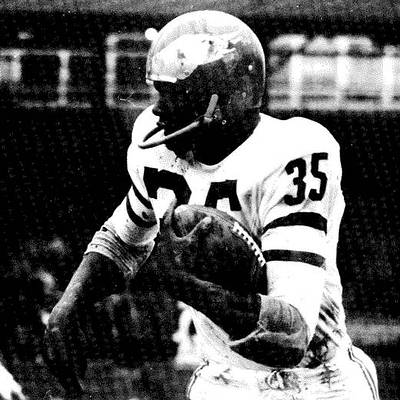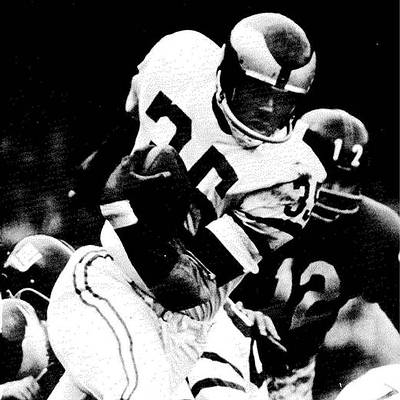

"Ted Dean"
HELMET REFLECTIONS FOR FEBRUARY 2009
"Ted Dean"
By Dr. Ken
On the anniversary of “The Greatest Game Ever Played” and the various other superlative laden names it is known by, it’s certainly understandable that other great games have been forgotten or ignored relative to the 1958 NFL Championship Game. There is no doubt that the game was significant for numerous reasons and there are enough books and television specials to both mark the occasion and give the behind-the-scenes insights that Giants and Colts fans crave. The game was my true introduction to professional football as I had immersed myself in the college game as a youngster and had little more than a vague awareness of the professionals, their teams, and the details of the season. I was quickly absorbed into the culture however and the pro game was as much a focus as the collegiate spectacles I tried to watch religiously, hurrying back to the house after my high school games which were played on Saturday afternoons. Home games would often allow me to watch at least a quarter of the college football broadcasts as the televised weekend game usually began a full hour after high school kickoff time. The professional game in the 1950’s through the mid-‘70’s was just as entertaining, a spirited group of very tough men who made a living at what they enjoyed and little more than that. When I am told that the players of that specific era could never play with the superior outsized athletes of today, I remind others that the limited rosters made for a very highly skilled and talented collection of players. Today’s expanded number of teams and bloated rosters have many more players who qualify as “replaceable parts” than true stars and the fat guys would be quickly gassed out if asked to play both ways or on special teams. “Then” was a better time, at least for me and I’ll take those games, those uniforms, and those helmets, thank you!
The 1960 game between the Packers and Philadelphia Eagles held more meaning for me than the 1958 NFL Championship classic. As a New York resident I was very familiar with the Frank Gifford, Kyle Rote, and Sam Huff Giants and was astute enough, even at a young age, to realize that the most visible stars needed the support of the Jack Strouds, Roosevelt Browns, and Jimmy Pattons. I was disappointed that the Giants missed out on the 1960 championship game, in part due to the calamitous hit put on Gifford by the Eagles’ fierce Chuck Bednarik, a tackle that has gone down as one of the greatest and most memorable in the history of football. The Vince Lombardi Packers were entering the first of their 1960’s run of championship games and were just beginning to grow into the dominant squad they would become. Even I realized that the Eagles were playing with an air of desperation, a last gasp at glory and a championship for their aging quarterback Norm Van Brocklin. The Dutchman’s retirement at the end of the season had been announced and he expected, was no doubt promised, to be named the Eagles’ head coach. The respect others had for his ability and almost overpowering desire to win every game forced the other Eagles to go to their absolute limit with none of them wanting to be the cause of a loss which might have denied Van Brocklin his final chance. Neither team was a true underdog in the sense that one was much better than the other. It was obvious however, that the Packers new regime, in its second season, was onto something that could be big, and the Eagles were perhaps not as well-known, not as solid, and certainly were not facing as bright a future. However one young, solid Eagle who really caught my attention was rookie halfback Ted Dean.
 |
Although the Lions’ end Gail
Cogdill was the NFL Rookie
Of The Year, Dean was
considered by many to be the
true star of the yearling
class. Dean was a
Philadelphia resident,
having graduated from Radnor
High School as an All State
performer in both football
and track and was named to
the National High School All
American team. Dean was good
enough to receive close
comparisons to former Radnor
grad and Pro Football Hall
Of Fame member Emlen Tunnell.
He and his high school
teammate Robert Blackwell
were recruited as a tandem
to Wichita State University.
Blackwell’s career as “the
other running back” was cut
short by injury but this
proved to be a mixed
blessing. Without football,
he focused on his academic
achievements and in time
became the highest ranking
African-American executive
for IBM and opened a
consulting firm that grossed
almost $40 million per year.
Dean’s collegiate career was
every bit as spectacular as
his high school achievements
had been, an All Missouri
Valley pick his junior and
senior seasons, he also
received Honorable Mention
All American accolades and
closed out his time with the
Shockers having gained more
than 1400 yards. He was
drafted in the fourth round
by the Eagles and made an
immediate impact, rushing
for 304 yards and proving to
be a dangerous and exciting
game breaker as a receiver
and return man. Dean in
fact, excited the Philly
fans like few had before him
with his explosive
acceleration and ability to
exploit defenses. Teamed
with Clarence Peaks, the
Eagles provided enough of a
ground game to allow Van
Brocklin to do what he did
best and that was to throw
to Tommy McDonald and Pete
Retzlaff.
 |
The 1960 NFL Championship
Game was a hard-hitting affair, led by tough guys Bednarik and the Packers’
fullback Jim Taylor. Dean’s five yard run proved to be the winning score in
the Eagles’ 17-13 victory and although Taylor was valiant and gave notice
that he would be a force in the league, it was Dean that seemed to have the
potential to be the most dynamic back in the NFL. Even George Halas stated
that Ted Dean was “going to become the best ever.” Living at home with his
parents in the Philadelphia suburbs and commuting to practice and games made
him a true “hometown hero.” Unfortunately, longevity wasn’t in the cards. I
kept tabs on the 6’1”, 205 pound back and noted that due to injury, he had
half the carries in 1961 than in the Eagles championship season. It was
worse in 1962 as he missed the entire year, suffering a broken foot after
appearing briefly as a return man in only the first two games. He never
fully recovered, played a limited role in ’63 and was traded to the Vikings
in 1964 where he touched the ball but seven times total before an auto
accident caused further physical damage. Ted Dean’s promising career had
ended. Though I can recall the power and speed he demonstrated and his
touchdown run in that classic 1960’s game, Dean is remembered by few. He
became a respected educator in the Philadelphia area but even as a “local
guy” has never received the respect he deserved. As the Eagles finish the
2008 season falling but one step short of a Super Bowl appearance, it’s as
good a time as any to recall the difference Ted Dean made in 1960.